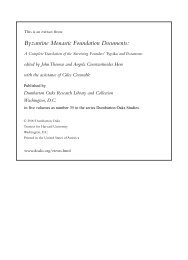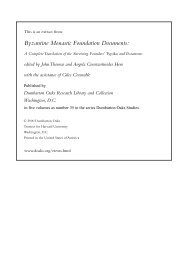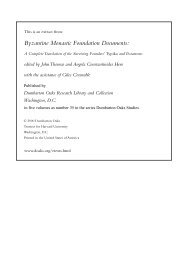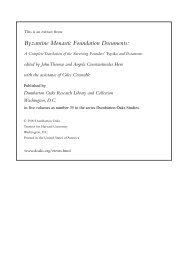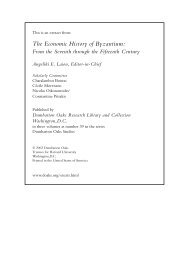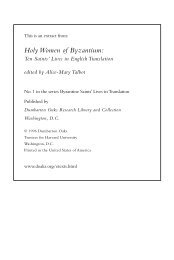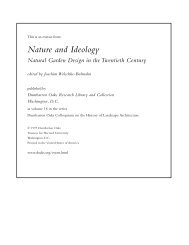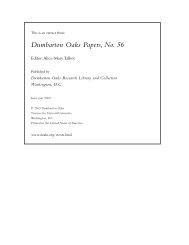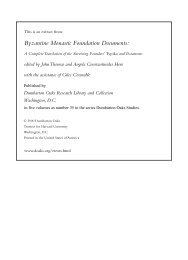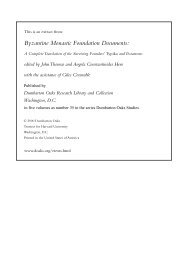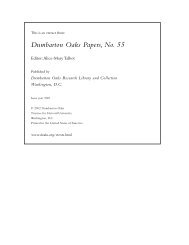Changing Economic Patterns in Latin Romania - Dumbarton Oaks
Changing Economic Patterns in Latin Romania - Dumbarton Oaks
Changing Economic Patterns in Latin Romania - Dumbarton Oaks
You also want an ePaper? Increase the reach of your titles
YUMPU automatically turns print PDFs into web optimized ePapers that Google loves.
David Jacoby [ 215 ]<br />
pr<strong>in</strong>cipality and the Greek despotate and thereby promote exchanges between these<br />
territories. 103 It should be noted that the region of Vervena was fairly close to the borderland<br />
further west <strong>in</strong> which later, <strong>in</strong> 1322, Frankish and Greek lords shared the revenue<br />
of several villages of the pr<strong>in</strong>cipality. 104<br />
The annual fair of St. Demetrius, attested <strong>in</strong> 1338, was presumably the most important<br />
of the three fairs of the Peloponnesos documented <strong>in</strong> the Lat<strong>in</strong> period. It was held <strong>in</strong>land<br />
at some distance from Chiarenza. Venetian merchants attend<strong>in</strong>g it were supposed to<br />
return with their goods to that city with<strong>in</strong> eight days after its conclusion. 105 The tim<strong>in</strong>g<br />
of this fair <strong>in</strong> late October co<strong>in</strong>cided with the market<strong>in</strong>g of agricultural and pastoral<br />
produce for export and the pass<strong>in</strong>g of Venetian state galleys and other ships return<strong>in</strong>g<br />
from the eastern Mediterranean to the Adriatic. 106 In view of the Byzant<strong>in</strong>e connotation<br />
of its name, one would assume that this fair was <strong>in</strong>herited from the Byzant<strong>in</strong>e period,<br />
yet this is far from certa<strong>in</strong>, <strong>in</strong> the same way as the use of the Greek term panhgúri" <strong>in</strong><br />
its Lat<strong>in</strong>, French, or Italian versions does not offer any clues with respect to cont<strong>in</strong>uity<br />
or the creation of new fairs <strong>in</strong> the Lat<strong>in</strong> period. 107 The St. Demetrius fair mentioned<br />
here may have developed from a local or regional event <strong>in</strong>to a more important gather<strong>in</strong>g<br />
after the foundation of Chiarenza, yet it is not excluded that it was established by a<br />
Frankish lord <strong>in</strong> order to take advantage of that port. As <strong>in</strong> the Byzant<strong>in</strong>e period, chang<strong>in</strong>g<br />
circumstances <strong>in</strong>duced landholders to transfer exist<strong>in</strong>g fairs to new locations or to<br />
establish new fairs on their estates. 108<br />
In the Venetian territories, developments regard<strong>in</strong>g markets and fairs appear to have<br />
been quite different from those occurr<strong>in</strong>g <strong>in</strong> the Peloponnesos. Fiscal expediency<br />
prompted the state to impose the channel<strong>in</strong>g of all commercialized rural products to<br />
urban markets by land and by sea, regardless of their ultimate dest<strong>in</strong>ation, <strong>in</strong> order to<br />
supervise and tax their sale. In Crete the maritime transportation of these products was<br />
directed toward the ma<strong>in</strong> ports of the island, namely, Candia, Canea, Rethymno, and<br />
Sitia. 109 Two late thirteenth-century customs lists record taxes levied at the land gate and<br />
<strong>in</strong> the harbor of Candia. 110 Goods brought for sale to the city had to be weighed or<br />
measured at the Commune’s official station located at the marketplace. This rule applied<br />
103 The proximity of the border is further illustrated by the events that followed the fair: Livre de la conqueste,<br />
para. 804–25. Note the chronicler’s remark that “nowadays [the fairs] are held <strong>in</strong> mid-June”: see text <strong>in</strong> previous<br />
note. It is impossible to determ<strong>in</strong>e whether this remark already appeared <strong>in</strong> the orig<strong>in</strong>al version of the chronicle,<br />
<strong>in</strong> which case it may reflect a change <strong>in</strong> tim<strong>in</strong>g related to the events of the 1270s, or <strong>in</strong> the abridged version<br />
of 1320–24. On the French versions of the chronicle, see D. Jacoby, “Quelques considérations sur les versions<br />
de la ‘Chronique de Morée,’” JSav (1968): 133–50, 181–89, repr. <strong>in</strong> idem, Société, no. vii.<br />
104 See Jacoby, “Coseigneurie,” 114–15.<br />
105 Baron Blanc, ed., Le flotte mercantili dei Veneziani (Venice, 1896), 59. See also Jacoby, “Silk Production,” 60.<br />
106 On state galleys and tim<strong>in</strong>g, see below, pp. 222, 228.<br />
107 For Lat<strong>in</strong> and French, see above, notes 101 and 102. The 14th-century Francesco Balducci Pegolotti, La<br />
pratica della mercatura, ed. A. Evans (Cambridge, Mass., 1936), 17, lists several equivalents of Tuscan mercato and<br />
fiera, among them panichiero <strong>in</strong> grechesco.<br />
108 See Laiou, “Händler,” 54–57.<br />
109 Note the provisions of 1316–17 prohibit<strong>in</strong>g the load<strong>in</strong>g or unload<strong>in</strong>g of goods <strong>in</strong> the bay of Dermata, to<br />
the west of Candia’s harbor, only fish<strong>in</strong>g boats be<strong>in</strong>g allowed to anchor there: P. Ratti Vidulich, ed., Duca di<br />
Candia: Bandi, Fonti per la storia di Venezia, Sez. I, Archivi pubblici (Venice, 1965) (hereafter Bandi), nos. 144,<br />
174.<br />
110 Ed. E. Gerland, Das Archiv des Herzogs von Kandia (Strasbourg, 1899), 108–9, and for their dat<strong>in</strong>g to<br />
1298–99, see 107 n. 1 and 135.




